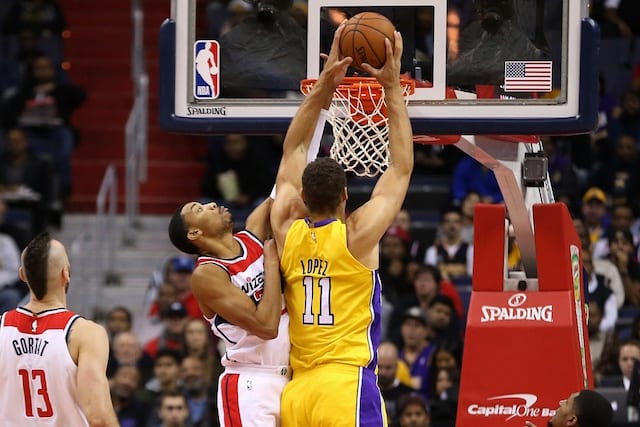When the Los Angeles Lakers front office chose to trade for Brook Lopez, it was clear the decision was at least in large part about the cap space and salary relief the one-year and $22.6 million remaining on his deal would provide.
But when introducing Lopez, Lakers President of Basketball Operations Magic Johnson and General Manager Rob Pelinka didn’t talk about cap space. They talked about how many threes Lopez made the year before and how his ability to score from behind the arc and out of post-ups would give the Lakers a dependable option offensively that the team had been lacking.
It all seemed a bit more like smoke and platitudes designed to pump up Lopez or gloss over the fact that the team had given up a No. 2 overall pick in D’Angelo Russell to gamble on cap space. But after a nondescript start to the season Lopez has come alive and made it seem like Johnson and Pelinka might have even undersold his effect.
13 games into the year, Lopez is leading the Lakers in scoring (15.3 points per game) while ranking second in 3-point percentage (35.8 percent).
The Lakers have been a moribund offensive team (ranking 28th in the league in offensive efficiency while scoring 97.4 points per 100 possessions), but they’re never better than when Lopez is on the floor, when they score 100.4 points per 100 possessions, a rate that would rank 25th in the NBA.
25th still isn’t great, but every bucket counts for a team as scoring-starved as the Lakers, and Lopez is equipped to get them in all kinds of ways. In addition to his prowess at shooting the ball from behind the arc, Lopez is shooting 63.6 percent in the restricted area, according to NBA.com, giving his young Lakers teammates a safety valve to duck in and score around the rim.
The Lakers are also a turnover-prone team, ranking second-to-last in the NBA in both turnovers per game (18.3) and turnover percentage (17.2 percent). Giving their opponents free possessions is not only a quick way to harm a team’s offensive efficiency, but it also allows them to get out in transition for easy scores.

Lopez being a large target who can create his own offense has allowed the Lakers to avoid turnovers while he’s on the floor. Of Lakers to play significant minutes, the team turns the ball over least while Lopez is playing, cutting their cough-ups to just 14.3 percent of their possessions during his minutes, which would rank third-best in the NBA.
And while Lopez isn’t known as a defender, his veteran smarts and sheer size have helped the Lakers limit their opponents to 99 points per 100 possessions when he plays, an improvement upon their already sixth-ranked defense that would give them the third-best defensive efficiency in the NBA if they could maintain it.
Lopez’s offensive and defensive help have made him exactly the type of invaluable contributor the Lakers were talking up when they traded for him, giving him not only the best net rating of any Laker to play more than 60 minutes this season, with the team outscoring opponents by 1.4 points per 100 possessions. Lopez is also the only Laker among that group of consistent contributors to have a positive net rating.

Further emphasizing Lopez’s impact is how the team plummets when he’s off the floor, getting outscored by a team-worst 8.3 points per 100 possessions when he sits. That gigantic differential would probably normalize a bit if Lopez played more minutes, but it’s still stark.
Making all of this improvement slightly awkward, rather than just a godsend for L.A., is Lopez’s status as a free agent at the end of this season. Instead of projecting as the perfect security blanket for young players like Lonzo Ball moving forward, the team will likely have to wave goodbye to the veteran center if it hopes to sign the two max free agents the front office is clearly thirsting for.
Some have theorized that a combination of cap space being so scarce next summer and team’s not needing centers could allow the Lakers to sign Lopez for less alongside their hoped-for free agent haul before then re-signing the following summer with his full Bird Rights. However that would be a lot of things going right for a Lakers organization that hasn’t had a ton of good fortune over the last several years.
Instead, Lopez is probably just the one-year rental most projected when the team initially acquired him. But while that may be true, his play in Los Angeles has also shown that the team wasn’t wrong about him being exactly what they needed for reasons beyond cap space, too.
WANT TO PARTICIPATE IN THE DISCUSSION? CHECK OUT THE NEW LAKERSNATION FORUM CLUB





